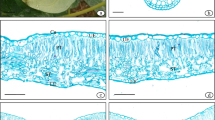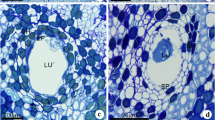Summary
Resolution of the ultrastructure of the needles of both Scots pine (Pinus silvestris L.) and Norway spruce [Picea abies (L.) Karst.] is strongly influenced by the molarity of the buffer used in fixation. When 0.2 M or 0.1 M buffer is used in fixation during the summer, the constituents of the cytoplasm are precipitated, resulting in poor resolution of the membranes and lamellae and often in negative staining. The tannin in the central vacuole appears as a thick ribbon. By using correct molarities of buffer during each season (0.1 M for autumn and winter and ca. 0.05 M for the growing season), the best possible resolution will be achieved. With good resolution the tannin in the central vacuole appears in granular form throughout the year, and the cytoplasm and its organelles are clearly distinguishable during every season. During the growing season, the chloroplasts in the needles of Scots pine are spread to the cell walls and have large starch grains; the stroma and grana lamellae are well developed; the stroma and cytoplasm are rich in polysomes. Mitochondria and microbodies can be clearly resolved. During hardening and afterwords throughout the winter, the chloroplasts, which at this time contain no starch, and other cytoplasmic organelles aggregate in the corners of the cells. The chloroplast envelopes and the stroma and grana lamellae stay intact. The cytoplasm is netlike and rich in ribosomes, mitochondria and microbodies, all of which are intact and clearly distinguishable. During spring activation the structure returns to that described for the growing season.
Similar content being viewed by others
References
Aronsson, A., Ingestad, T., Lööf, L.-G., 1976: Carbohydrate metabolism and frost hardiness in pine and spruce seedlings grown at different photoperiods and thermoperiods. Physiol. Plant.36, 127–132.
Campbell, R., 1972: Electron microscopy of the development of needles ofPinus nigra var.maritima. Ann. Bot. (London)36, 711–720.
Chabot, J. F., Chabot, B. F., 1975: Developmental and seasonal patterns of mesophyll ultrastructure inAbies balsamea. Can. J. Bot.53, 295–304.
Finnish Meteorological Institute 1978. Meteorological Yearbook of Finland 1978.
Harris, W. M., 1971: Ultrastructural observations on the mesophyll cells of pine leaves. Can. J. Bot.49, 1107–1109.
Huttunen, S.,Kärenlampi, L.,Kolari, K., in press: Changes in osmotic potential and some related physiological variables in needles of polluted Norway spruce (Picea abies).
Lewis, F. J., Tuttle, G. M., 1920: Osmotic properties of some plant cells at low temperatures. Ann. Bot.34, 405–416.
Linder, S., 1972: Seasonal variation of pigments in needles. A study of Scots pine and Norway spruce seedlings grown under different nursery conditions. Stud. For. Suec.100, 1–37.
Martin, B., Öquist, G., 1979: Seasonal and experimentally induced changes in the ultrastructure ofPinus silvestris. Physiol. Plant.46, 42–49.
Ollykainen, A. M., 1969: Dynamics of the plastid pigments in leaves of some trees in Karelia. Lesovedenie2, 72–76. (Cf. Chem. Abstr., 71, 46694 y.)
—, 1970: Plastid pigments in spruce needles. Izv. Vyssh. Ucheb. Zaved. Les. Zh.13 (2), 151–152. (Cf. Chem. Abstr., 73, 127724.)
Parker, J., Philpott, D. E., 1961: An electron microscopic study of chloroplast condition in summer and winter inPinus strobus. Protoplasma53, 575–583.
Perry, T. O., Baldwin, G., 1966: Winter breakdown of the photosynthetic apparatus of evergreen species. For. Sci.12, 298–300.
Senser, M., Schötz, F., Beck, E., 1975: Seasonal changes in structure and function of spruce chloroplasts. Planta (Berl.)126, 1–10.
Soikkeli, S., 1978: Seasonal changes in mesophyll ultrastructure of needles of Norway spruce (Picea abies). Can. J. Bot.56, 1932–1940.
—,Tuovinen, T., 1979: Damage in mesophyll ultrastructure of needles of Norway spruce in two industrial environments in central Finland. Ann. Bot. Fennici16, 50–64.
Walles, B., Nyman, B., Aldén, T., 1973: On the ultrastructure of needles ofPinus silvestris L. Stud. For. Suec.106, 1–26.
Zacharowa, T. M., 1929: Über den Gasstoffwechsel der Nadelholzpflanzen im Winter. Planta8, 68–83.
Author information
Authors and Affiliations
Rights and permissions
About this article
Cite this article
Soikkeli, S. Ultrastructure of the mesophyll in scots pine and Norway spruce: Seasonal variation and molarity of the fixative buffer. Protoplasma 103, 241–252 (1980). https://doi.org/10.1007/BF01276270
Received:
Accepted:
Issue Date:
DOI: https://doi.org/10.1007/BF01276270




